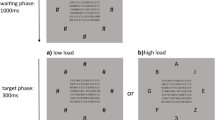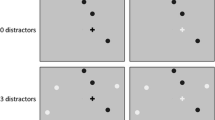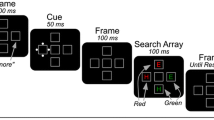Abstract
When participants are attending to a subset of visual targets or events and ignoring irrelevant distractors (“selective looking”), they often fail to detect the appearance of an unexpected visual object or event even when the object is visible for several seconds (“sustained inattentional blindness”). An important factor influencing detection rates in selective looking is the attentional set of the participant: the more similar the features of the unexpected object are to the attended ones, the more probably it will be detected. We examined the possible contribution of active ignoring to this similarity effect by studying the role of the distractor objects in sustained inattentional blindness. First we showed the similarity effect for chromatic colors and then we manipulated the similarity of the unexpected object in relation to the distractor objects and did not find any effects. Moreover, we found that inattentional blindness was present even when the displays did not contain any irrelevant to-be-ignored objects. We conclude that attending to target items on the basis of attentional set, but not active ignoring of nontargets items, is sufficient for the occurrence of sustained inattentional blindness.


Similar content being viewed by others
References
Becklen, R., & Cervone, D. (1983). Selective looking and the noticing of unexpected events. Memory and Cognition, 11, 601–608.
Block, N. (2005). Two neural correlates of consciousness. Trends in Cognitive Sciences, 9, 46–52.
Folk, C. L., Remington, R. W., & Johnston, J. C. (1992). Involuntary covert orienting is contingent on attentional control settings. Journal of Experimental Psychology: Human Perception and Performance, 18, 1030–1044.
Folk, C. L., Remington, R. W., & Wright, J. H. (1994). The structure of attentional control: contingent attentional capture by apparent motion, abrupt onset, and color. Journal of Experimental Psychology: Human Perception and Performance, 20, 317–329.
Koivisto, M., Hyönä, J., & Revonsuo, A. (2004). The effects of eye movements, spatial attention, and stimulus features on inattentional blindness. Vision Reseach, 44, 3211–3221.
Lamme, V. A. F. (2004). Separate neural definitions of visual consciousness and visual attention; a case for phenomenal awareness. Neural Networks, 17, 861–872.
Mack, A., & Rock, I. (1998). Inattentional blindness. Cambridge, MA: MIT Press.
Most, S. B., Scholl, B. J., Clifford, E. R., & Simons, D. J. (2005). What you see is what you set: Sustained inattentional blindness and the capture of awareness. Psychological Review, 112, 217–242.
Most, S. B., Simons, D. J., Scholl, B. J., & Chabris, C. F. (2000). Sustained inattentional blindness: The role of location in the detection of unexpected dynamic events. Psyche, 6(14), http://www.psyche.cs.monash.edu.au/v6/psyche-6-14-most.html.
Most, S. B., Simons, D. J., Scholl, B. J., Jimenez, R., Clifford, E., & Chabris, B. (2001). How not to be seen: the contribution of similarity and selective ignoring to sustained inattentional blindness. Psychological Science, 12, 9–17.
Neisser, U. (1979). The control of information pickup in selective looking. In A. D. Pick (Ed.) Perception and its development. A tribute to Eleanor Gibson (pp. 201–219). Hillsdale, NJ: Lawrence Erlbaum.
Newby, E. A., & Rock, I. (1998). Inattentional blindness as a function of proximity to the focus of attention. Perception, 27, 1025–1040.
Revonsuo, A. (2006). Inner presence: Consciousness as a biological phenomenon. Cambridge, MA: MIT Press.
Simons, D. J. (2000). Attentional capture and inattentional blindness. Trends in Cognitive Sciences, 4, 147–155.
Simons, D. J., & Chabris, C. F. (1999). Gorillas in our midst: sustained inattentional blindness for dynamic events. Perception, 28, 1059–1074.
Simons, D. J., & Levin, D. T. (1997). Change blindness. Trends in Cognitive Sciences, 1, 261–267.
Turatto, M., & Bridgeman, B. (2005). Change perception using visual transients: Object substitution and deletion. Experimental Brain Research, 167, 595–608.
Wolfe, J. M. (1999). Inattentional amnesia. In: V. Coltheart (Ed.), Fleeting memories: Cognition of brief visual stimuli (pp. 71–94). Cambridge, MA: MIT Press.
Acknowledgment
This study was supported financially by the Academy of Finland (project numbers 45704, 47238, 49152, and 205661).
Author information
Authors and Affiliations
Corresponding author
Rights and permissions
About this article
Cite this article
Koivisto, M., Revonsuo, A. The role of unattended distractors in sustained inattentional blindness. Psychological Research 72, 39–48 (2008). https://doi.org/10.1007/s00426-006-0072-4
Received:
Accepted:
Published:
Issue Date:
DOI: https://doi.org/10.1007/s00426-006-0072-4




